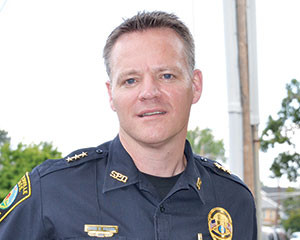By Josie Grove

Somerville Police Dept. Chief Fallon affirmed his commitment to pursuing a policy of encouraging rehabilitation over making arrests in dealing with the drug addiction problem in the city.
“We face a very big issue,” said Alderman at large Jack Connolly at the beginning of last week’s Public Health and Public Safety Committee meeting. Somerville’s Health and Human Services Department, together with the Somerville Police Department, has put together a new plan to deal with opioid abuse in the city. The plan will attempt to rehabilitate people in the community, rather than arresting them.
“Every community is different but in Somerville, possession-only offenses, excluding the Good Samaritan situations, 76% of the time we’re resolving those issues without arrest,” said Fallon, referencing the practice of not arresting people who call 911 for help with an overdose, even if they are also using drugs. Fallon says this is a cultural change for police officers. “If you want to advance in the Somerville police department, don’t arrest someone. Get someone to the next level of care, document that, and we’ll promote you up through the ranks.”
The plan, noted Ward 1 Alderman Matt McLaughlin, did not include heavy emphasis on inpatient treatment. “We need to figure something out,” said the alderman, who was present as an observer. “If the city doesn’t have the resources for it, we should be lobbying the state for it.” Contente agreed. “There’s a lack of actual treatment in our community. There are very limited resources,” she said, noting that the available inpatient treatment beds are not enough to meet demand.
The plan focused more on what the city can provide outside of inpatient treatment.
“How do we build community capacity to support recovery?” asked Contente. “We really recognize that there’s really not enough there.”
John Harding, community analytics manager in the Mayor’s Office of Innovation and Analysis, presented policy recommendations to support the plan. “How can we restructure the treatment apparatus to improve outcomes at the community level?” he asked. The recommendations focus on what Harding called “full lifestyle rehabilitation” to help people rebuild their lives by providing support and shelter. “I don’t mean a homeless shelter, but a home for these patients,” said Harding. Support would be broad under the plan: treatment with Suboxone, a drug used lessen opioid cravings, in conjunction with cognitive therapy. “No one patient’s recovery needs is exactly like the next,” said Harding. He says the plan will “shift the model from inpatient or nothing, to figuring out what works for the individual, using organic supports implanted in the community.”
“Why does opioid misuse persist despite the existence of a large regional treatment system?” asked Harding. “Because our system is not built to treat the whole patient.”
This program will treat whole patients with only three new part-time city staff: a jail diversion coordinator, who helps divert people into treatment; a victim witness advocate; and an addiction coordinator, who connects or reconnects addicts with recovery services. Contente estimates that each of their caseloads would be between forty and fifty people.
“We recognize that there are many different levels,” said Contente. “Forcing someone into treatment is sometimes necessary to save their life. But sometimes they’re just not buying into it.”
The city of Somerville is not the only governing body working on this issue. Governor Charlie Baker proposed a controversial bill at the state level last month. That bill takes a very different approach from the city’s plan. Governor Baker’s bill seeks to prevent opioid addiction by restricting people prescribed the drugs to a 72-hour supply, and would empower hospitals coerce users into treatment.
By contrast, the city’s plan attempts to encourage people to opt in to treatment. “What we’re interested in is how we can support people in the context of community, how we can improve their quality of life in the community,” said Contente.
Jesse Clingan of the Somerville Harm Reduction Collaborative sees a sharp contrast between the state bill and Somerville’s plan. “One plan is putting a hand out there, and the other plan is grabbing that hand and throwing a cuff on it.”
“What’s happening in Somerville is a harm reduction approach,” says Clingan. “It’s reaching out to people who have overdosed and seeing if they want treatment rather than forcing it on them.”















Reader Comments